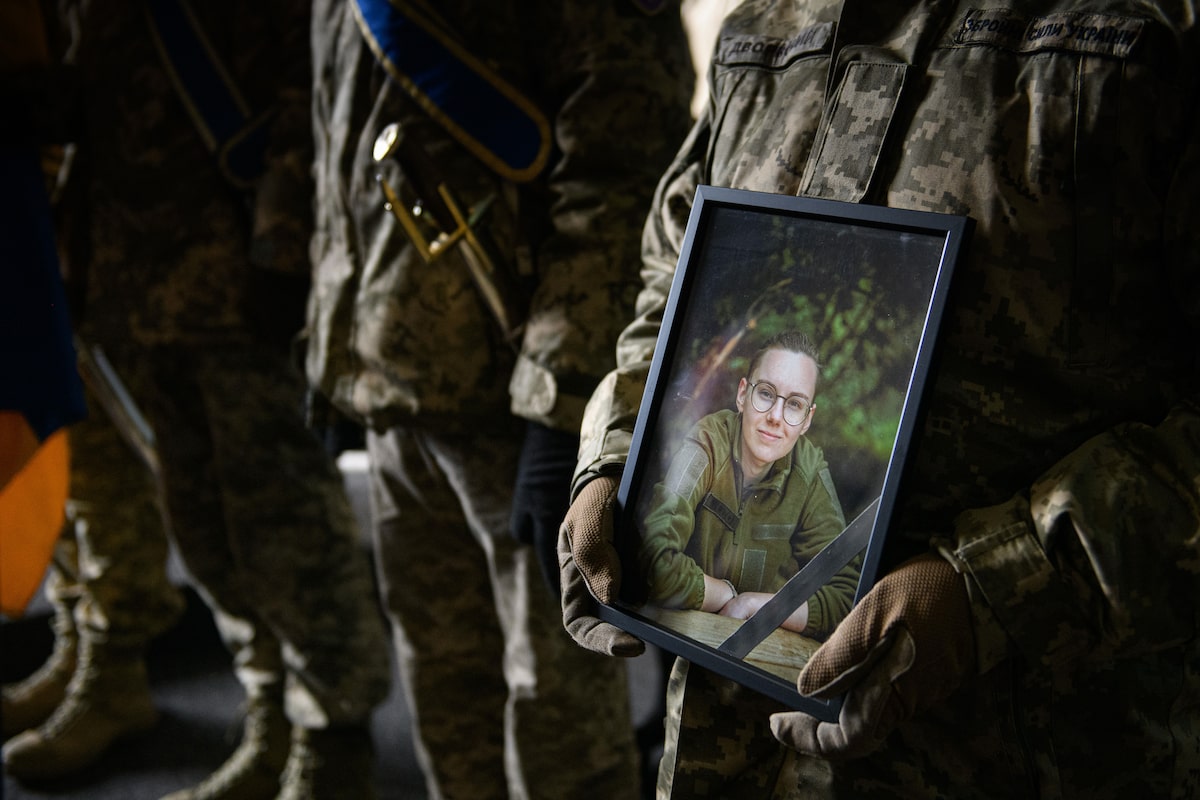A farewell ceremony is held for Maria Zaitseva, a 24-year-old Belarusian volunteer soldier who fought for Ukraine, in Kyiv, on Feb. 3.Olga Ivashchenko/The Globe and Mail
Maria Zaitseva first emerged as a heroine of the Belarusian democracy movement five years ago, when she was photographed covered in blood after being wounded in the protests that followed her country’s stolen 2020 election.
This week, her funeral was held in Kyiv, almost three weeks after Ms. Zaitseva was killed in the war for Ukraine, which she saw as deeply connected to her own country’s struggle for freedom. Many Belarusian volunteers have been fighting for Ukraine since Russian President Vladimir Putin launched a full-scale invasion of the country three years ago, believing that defeating Russia in Ukraine is key to liberating Belarus.
The funeral was held just more than a week after Belarusian President Alexander Lukashenko was sworn in for another five-year term, after an election dismissed by Canada and other Western governments as a “sham.”
Opinion: Belarus will ‘elect’ a dictator again. But the fight for freedom is not over
Nicknamed “Odyssey,” the Belarusian activist-turned-volunteer-soldier, was killed in action on Jan. 17 near the eastern Ukrainian city of Pokrovsk. It was one day after her 24th birthday.
Dozens of combatants and civilians gathered on Monday at Kyiv’s main crematorium to mourn Ms. Zaitseva, who was the first female member to be killed in action from the Second Battalion of the International Legion for the Defence of Ukraine.
Ruslan Myroshnychenko, the 55-year-old founder and former commander of the Second Battalion, said that Ms. Zaitseva was about the same age as one of his two children, so he always perceived her as another daughter.
Ms. Zaitseva, a Belarusian activist-turned-volunteer-soldier, was killed in action on Jan. 17 near the eastern Ukrainian city of Pokrovsk.Olga Ivashchenko/The Globe and Mail
“What was a high school student doing in my unit?” Colonel Myroshnychenko recalled on Monday as he remembered their first meeting, smiling at the memory. “But in this high school student, a very well-formed personality appeared, adult eyes, adult thoughts, an adult’s fully formed determination to fight.”
Ms. Zaitseva’s parents could not attend the public farewell for their only daughter as it is nearly impossible for Belarusian citizens to cross the border with Ukraine. At their request, Krystsina Shyjanok, director of the office representing Belarus’s pro-democracy opposition, who is in exile in the Czech Republic, placed a religious icon and white roses in the coffin.
“Maria advocated for equality everywhere, and I saw in her such an epicentre of feminist ideas,” Ms. Shyjanok, 38, said. “Quite often in our communication, I did not feel the difference in our ages, although we belonged to completely different generations.”
Krystsina Shyjanok, director of the office representing Belarus’ pro-democracy opposition in the Czech Replublic, placed a religious icon and white roses in the coffin at the request of Ms. Zaitseva’s family, who were unable to cross from Belarus to Ukraine to attend the ceremony.Olga Ivashchenko/The Globe and Mail
Born in the Belarusian city of Gomel, Ms. Zaitseva was 19 and studying to be a veterinarian on Aug. 9, 2020, when she joined the protests in Minsk against the outcome of the presidential election, which many Belarusians believe was won by opposition candidate Sviatlana Tsikhanouskaya. There, Ms. Zaitseva was injured by rubber bullets, as well as shrapnel from a stun grenade. She underwent surgeries in Belarus and continued treatment in the Czech Republic, but she never fully regained hearing in her right ear.
After the outbreak of the full-scale war in Ukraine in 2022, Ms. Zaitseva helped Ukrainian refugees in the Czech Republic until the spring of 2023, when she joined the International Legion. She worked initially as a medic, and Colonel Myroshnychenko said that with “her ice-cool composure she saved many lives.”
Ms. Zaitseva received a serious shrapnel injury to her hand in 2023 while working as a trench paramedic. After undergoing treatment and rehabilitation in Prague, she said that she wanted to return to Ukraine – this time as a sniper. And this despite the fact that her hand motor skills were not fully restored.
Analysis: Trump is promising to end the war in Ukraine. But is Putin ready to stop?
By the fall of 2024, she was taking part in combat missions near the city of Chasiv Yar, on Ukraine’s southeastern Donbas front. Colonel Myroshnychenko described her as a “very effective sniper.”
Pavlo Shurmei, the commander of the Kastus Kalinowski Regiment, an all-Belarusian unit attached to the Ukrainian armed forces, attended the ceremony out of respect for a fallen “daughter of the Belarusian people,” even though she had not served in his regiment.
“People must understand that we are fighting here for Ukraine, for Belarus, and for the entire civilized world.”
A few minutes before Ms. Zaitseva was to be cremated, opposition leader Ms. Tsikhanouskaya intervened to ask Kyiv’s Mayor to give permission for Ms. Zaitseva to be buried next to her fellow Belarusian fighters.
